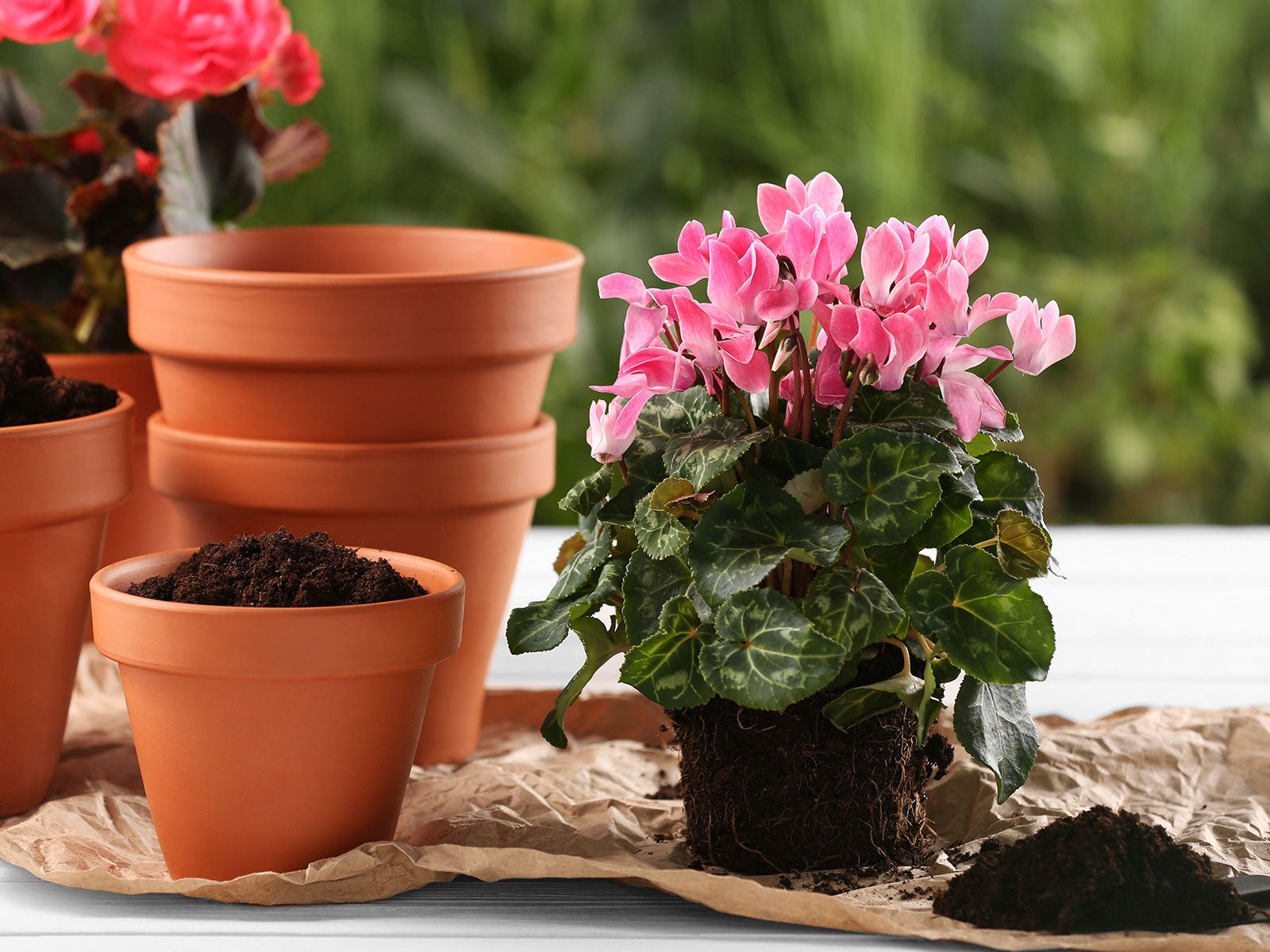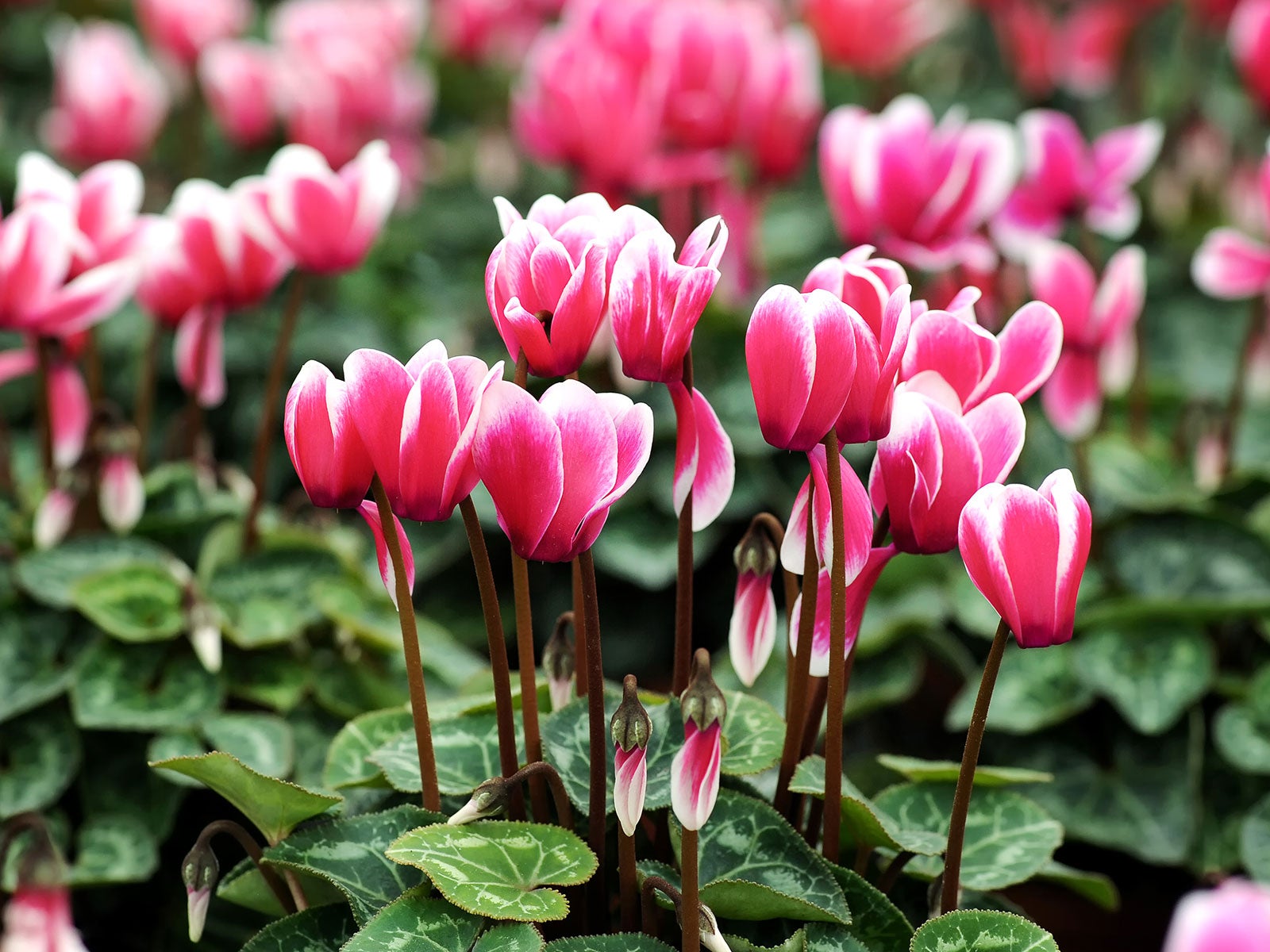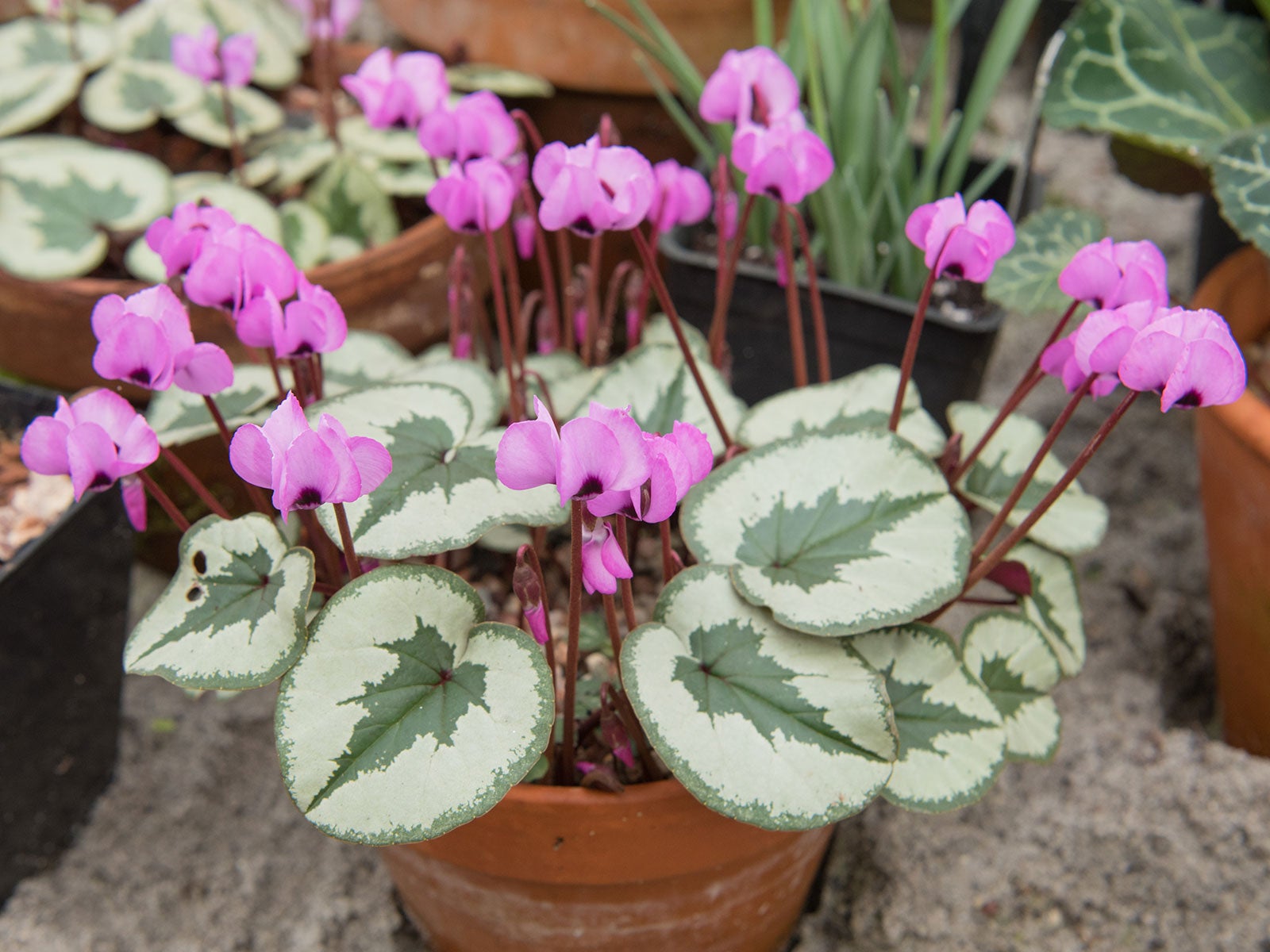Cyclamen Care Made Simple: How To Get More From Cyclamen Plants


Quick Cyclamen Facts
- Botanical name – Cyclamen persicum
- Height – 6-9 inches (15-23cm)
- Spread – 6-9 inches (15-23cm)
- Sun exposure – Partial shade
- Soil requirements – Neutral, slightly acidic
- Hardiness zones – USDA 9-11
- When to plant – Fall
The right cyclamen care will reward you with some of winter’s most charming and vibrant bloomers. Cyclamens are known for their petite stature and quaint blooms. They can make attractive perennial garden plants and effective groundcover through their hardiness range. Certain cultivars can also be grown as stunning container displays. Learning how to care for cyclamen is a great way to add color during the coldest months of the year.
There are over 20 species of cyclamen available to gardeners. Though these types are similar in form and structure, they can vary in bloom time. Hardiness levels also differ from one species to the next, with some cultivars being more tolerant of the cold. Certain varieties such as Cyclamen persicum (aka florist’s cyclamen) are not frost-tolerant. That said, they can be kept going beyond their first flush of flowers if given the right treatment.
Cyclamen Plant Care Made Simple
Caring for a cyclamen begins with deciding whether you are going to be growing outside or inside, in the ground or in containers. In nature, cyclamen plants grow in cool, humid environments. Hardy types of cyclamen sold for outside use are typically hardy to USDA zone 5. Check the plant’s label to determine the specific hardiness of the cyclamen variety you wish to grow.
This distinction between indoor and outdoor growing is critical to making the right plant selection. For example, cyclamen that are sold as houseplants are tropical and cannot tolerate temperatures below 40 degrees F (4°C). However, if temperatures are too high, the plant will begin to yellow and the flowers will fade rapidly. So bear this in mind if growing cyclamen indoors.

image: DRpics24 / Getty
How to Care for Cyclamen Indoors
For anyone growing hardy cyclamen outdoors, there are relatively few cultivation essentials to worry about on a regular basis. Once you have selected a good spot outdoors in the correct hardiness zone, ongoing cyclamen care mainly involves sensible watering. However, indoor cyclamen care requires just a little more attention. This is especially important if you wish to keep your plants growing and flowering year after year, as you may occasionally notice drooping cyclamen plants midseason.
Best Light for Cyclamen
Cyclamen grow best in partial shade and prefer bright, indirect light. For the best cyclamen care indoors, try to recreate the conditions that help them thrive outside. Experienced growers suggest situating these plants near a south-facing window throughout winter, making certain to avoid direct sun. Dimmable grow lights, like these ones from Amazon, are also a great option to replicate indirect sun.
Temperature & Humidity
Temperatures need to be consistently cool, between 60-65°F (15-18°C). Cyclamen houseplants also need high humidity levels to maintain a lush, glossy appearance. You can raise humidity for houseplants by misting frequently and placing the container in a small dish of gravel containing water, like the Brussel's Bonsai Humidity Tray from Amazon. Avoid placing cyclamen near vents and move them safely away from drafts.
Sign up for the Gardening Know How newsletter today and receive a free copy of our e-book "How to Grow Delicious Tomatoes".
Watering Cyclamen
Consistent moisture is a key aspect of cyclamen plant care, especially for container-based options. When the top third of the soil or compost has dried, water cyclamen in pots thoroughly. Bear in mind that watering container plants from above can lead to fungal diseases within the plant, specifically the crown. Water at the base of the plant so as to avoid splashing the stems or leaves. Soak the soil thoroughly and let excess water drain away.
Fertilizing Cyclamen
While indoor cyclamen plants require routine fertilization, it’s important to avoid overfeeding. A surplus of nutrients within the soil leads to excessive leafy growth. When feeding cyclamen plants, use only low-nitrogen fertilizers every six weeks to two months. Continue feeding during the growing season, but cease as the plant approaches dormancy.
Soil & Compost
When grown outdoors, cyclamen just require a soil that drains well, with a neutral or slightly acidic pH. For indoor growing, choose a compost for your houseplant that blends good moisture retention with adequate drainage. Most high-quality potting mixes are suitable for good indoor cyclamen care. We recommend this Back to the Roots 100% Organic Indoor Potting Mix from Amazon. Gardeners can also create their own medium using a combination of compost, coconut coir, perlite and other amendments.

image: Olga Yastremska / Alamy
Planting and Container Care for Cyclamen
In the garden, cyclamen are most commonly planted in the fall. Established plants are generally moved into pots at this time and taken indoors. Planting cyclamen in containers allows growers to maintain their favorite varieties throughout winter and even helps to encourage them to bloom. To thrive, container grown cyclamen plants will grow best in pots that are twice the depth and width of the plant’s root ball.
For optimum growth, repot cyclamen plants every two to three years. If you are repotting a cyclamen plant, wait until it is dormant (in other words, not actively growing).
Best Cyclamen Care When Flowering Stops
Once a cyclamen stops flowering, this is when it will enter its dormant state. The right care during a cyclamen dormancy period is critical to the future health and flowering potential of the plant. Most cyclamen will require an extended period of dormancy in order to bloom again. Sadly, this can often be confused with dying, as it involves leaves turning yellow and falling off.
The best cyclamen care after blooming involves ensuring your plants can settle and rest undisturbed and unimpeded. To help plants prepare for dormancy, growers can deadhead or remove spent flower stalks back to the base of the plant. As cyclamen approach dormancy, you should also reduce the frequency of watering.
How to Make Cyclamen Plants Bloom Again
With proper cyclamen care, you can help your plant through its dormancy so it will bloom again in a few months. Hardy cyclamen planted outdoors go through this process naturally. Indoors, make sure cyclamen are kept in a relatively dark as well as cool environment while sleeping. Gently remove any dead foliage and leave to sit for a couple of months.
When a cyclamen has finished its dormancy period, you can start to water it again and bring it out of storage. New leaf growth is a good indication that your plant is waking up. At this point, you can set the pot in a tub of water for an hour or so, before letting any excess water drain away. Once leaves start to grow, resume normal cultivation. Even if cyclamen plants are not blooming again straight away, these steps to optimal cyclamen flower care should ensure they rebloom the following winter.

image: Photology1971 / Shutterstock
Pruning Cyclamen Plants
Cyclamen in pots seldom require pruning. However, during their life cycle there are times when they will benefit from the removal of plant matter. Though not essential, deadheading flowers that have faded will help to keep pots looking their best. Further deadheading is beneficial at the end of the bloom cycle, as the plant prepares for dormancy. As cyclamen foliage begins to yellow, clip stems to soil level to help prevent disease.
How to Propagate Cyclamen
As well as knowing how to care for cyclamen to keep existing plants healthy, you can use propagation to increase your winter blooms. You can propagate cyclamen plants by using division and by gathering seed. Fresh seed will germinate well but the process can be lengthy, ranging from several weeks to over a year. Dividing established cyclamen is a quicker way to increase numbers. Dig up tubers during the plant’s dormancy period. Cut each tuber carefully into smaller segments for replanting. Each part should have at least one viable growth eye.
Cyclamen Problems, Pests and Diseases
Though indoor cyclamen care is relatively simple, it’s important to be aware of the development of key diseases. Overwatering cyclamen plants makes them especially susceptible to rot. Some common cyclamen disease include tuber rot and pythium root rot, which can happen when cyclamen grows with inadequate drainage. Powdery mildew and forms of wilt may also be problematic. These can occur in cramped conditions where you haven’t given plants good airflow and ventilation.
Indoor plants are only seldom plagued by pests, but you may find that aphids or mites can become an issue if left untreated. Tackle with diluted soap washes or horticultural sprays like Bonide Captain Jack's Neem Oil Spray from Amazon. If growing outside, encourage beneficial predators like lacewings, which can also help control numbers.

image: Peter Turner Photography / Shutterstock
Frequently Asked Questions
Is Cyclamen a Perennial or an Annual?
Within their hardiness range, cyclamen plants are considered to be a dependable perennial groundcover. Those growing the plant indoors, outside of its range, most often treat cyclamen as an annual plant and forget about them once they stop flowering. However, it is possible to keep cyclamen as a perennial. Just allow potted plants to go dormant through the summer months, then give them some tender loving care when they spring back into life ahead of the next flowering season.
When do Cyclamen Become Dormant?
Dormancy in cyclamen plants will vary, depending upon your growing zone. In general, if you are growing them indoors, you can expect them to begin showing signs of dormancy sometime in early-mid spring. By summer, most plants will have died back completely. Dormancy usually lasts for around two months, at which point you can restart the cycle of cyclamen care as you head back towards winter.
Cyclamen Care Essentials
- Dimmable grow lights, like these ones from Amazon, are a great option to replicate the growing conditions your Cyclamen needs.
- You can raise humidity for houseplants by misting frequently and placing the container in a small dish of gravel containing water, like the Brussel's Bonsai Humidity Tray from Amazon.
- Most high-quality potting mixes are suitable for good indoor cyclamen care. We recommend this Back to the Roots 100% Organic Indoor Potting Mix from Amazon.
- You may find that aphids or mites can become an issue and can be treated with Bonide Captain Jack's Neem Oil Spray from Amazon.

Heather Rhoades founded Gardening Know How in 2007. She holds degrees from Cleveland State University and Northern Kentucky University. She is an avid gardener with a passion for community, and is a recipient of the Master Gardeners of Ohio Lifetime Achievement Award.
- Tonya BarnettWriter
- Amy DraissDigital Community Manager